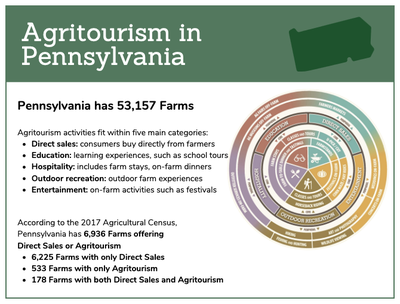
Just released: Agritourism and direct sales fact sheets for all 50 US states
June 2, 2023
A new set of fact sheets provides comprehensive insights into the demographics of U.S. farms that offer agritourism activities or sell food directly to consumers or both. The fact sheets are available for all 50 states and are intended to help local decision makers, farmers, and the organizations that support them in their efforts to strengthen and expand agritourism enterprises.
“These fact sheets are meant to be a resource for the people working to increase the number of agritourism operators in their areas,” said Claudia Schmidt, assistant professor of marketing and local/regional food systems in Penn State’s College of Agricultural Sciences, who led the effort. “They contain data that will be especially useful to people writing grants and proposals when they want to describe how many farms are out there, the types of agritourism activities they’re engaged in, and how much money they’re earning from these activities.”
Developed by Schmidt and other collaborators at Penn State, University of Vermont, University of Maine, and Oklahoma State University, each fact sheet provides the total number of farms in the state and the number engaging in agritourism, in direct sales, and in both activities. They also include detailed demographic and business information about these farms, including farmer age and gender, crops grown, farm size, and farm income generated by agritourism and direct sales.
For example, their analysis of Pennsylvania shows that there are 53,157 total farms, including 6,225 that sell their products directly to consumers, 533 that offer agritourism activities but don’t sell directly to consumers, and 178 that engage in both activities. Of those engaging in both, the majority of farms are more than 10 years old and earn more than $10,000 annually through these activities.
In addition to state-level insights, the data also reveal regional and national trends. For example, they found that agritourism and direct sales activities are most prevalent in the Northeast states, accounting for about one-fifth of all the U.S. farms that offer some form of agritourism, including direct sales. Jason Entsminger, University of Maine Assistant Professor of Entrepreneurship and Innovation and Assistant Extension Professor and Small Business Specialist, sees potential opportunity for regional collaboration in these numbers.
“In places like New England where agritourism is a more common entrepreneurial strategy, agritourism ventures may find greater success through collective means, forming a clear regional identity and building a critical mass of farms cooperating to some degree,” Entsminger said. “These fact sheets are one more tool to help entrepreneurs and the organizations supporting them take stock of where their state is at in developing strong entrepreneurial environments for agritourism ventures.”
The fact sheets draw from USDA Census of Agriculture data that are not publicly available but were obtained through a special data request filed by Lisa Chase, University of Vermont Extension Professor and Director of the Vermont Tourism Research Center. These data allowed the researchers to differentiate between agritourism and direct sales in ways that are not possible with the publicly accessible Census data, and to conduct a more detailed analysis of the number and types of farms that are using one or both of these strategies.
“As agritourism and direct sales become increasingly important to farm viability and rural community vitality, we need better data to help us understand trends around the US. Here in Vermont, much of what we consider to be agritourism — such as pick-your-own and meals on farms — is categorized as direct sales by the Census of Agriculture,” said Chase. “And while the Census reports direct sales and agritourism as separate activities, in reality it makes sense to consider them together because that more accurately reflects the consumers’ experience.”
The Census of Agriculture defines agritourism as “agri-tourism and recreational services such as farm or winery tours, hay rides, hunting, fishing, etc.” Direct sales refer to sales of products for human consumption made directly from farmer to consumer, for example at a “pick-your-own” operation, farm stand or farmers market, or through subscription-based arrangements.
The fact sheets are available at the Penn State Agritourism Extension website:
https://aese.psu.edu/outreach/agritourism/projects/nifa-agritourism/state-factsheets
Other collaborators on the fact sheets included Kacey Lo, an undergraduate student researcher at Penn State; Chadley Hollas of Cultivating Tourism, a tourism research and consulting firm based in Austin, Texas; Stacy Tomas, associate professor of hospitality and tourism management at Oklahoma State University; and Stephan J. Goetz, professor of agricultural and regional economics at Penn State and director of the Northeast Regional Center for Rural Development (NERCRD). The research was supported by the United States Department of Agriculture, National Institute of Food and Agriculture (NIFA), the Agricultural Marketing Resource Center (AgMRC), located at Iowa State University, and the Pennsylvania State University and NIFA Multistate/Regional Research and Extension Appropriations under Project #NE2249.
